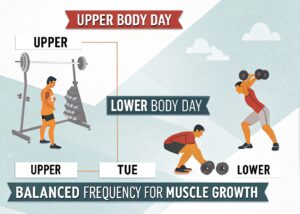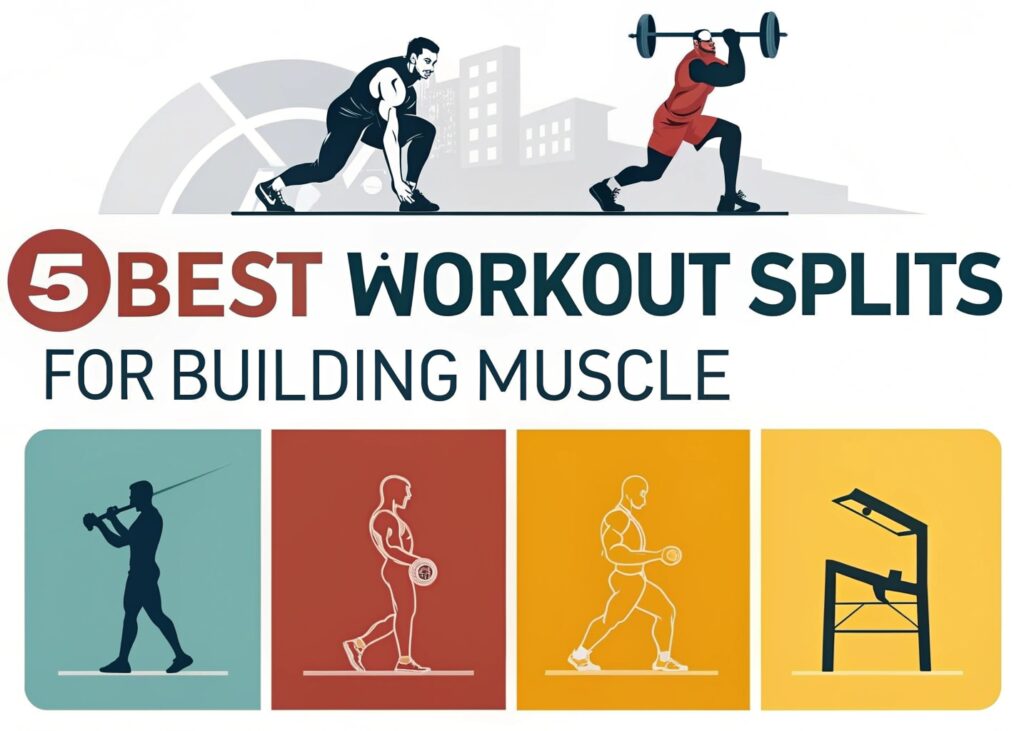Introduction
Best Workout Splits for Building Muscle- When it comes to sculpting a stronger, more muscular physique, the way you organize your training week can be just as important as the exercises you perform. In this post we break down The 5 Best Workout Splits for Building Muscle so you can choose the system that matches your schedule, experience level, and growth goals. Whether you’re a busy professional, a college athlete, or a seasoned bodybuilder, understanding the strengths and limitations of each split empowers you to train smarter, recover better, and keep the plate‑aus at bay. Below you’ll find research‑backed explanations, practical programming tips, and real‑world examples that will help you implement the perfect split for hypertrophy and long‑term progress.
Beyond the headline, the next two paragraphs dive into why a well‑structured split matters for muscle hypertrophy, the hormonal and metabolic responses that drive gains, and how to align your split with nutrition and sleep. Let’s start with the fundamentals before we explore each of the five top‑rated splits.
Muscle growth is a product of three core variables: mechanical tension, metabolic stress, and muscle damage. A smart split maximizes these stimuli by giving each major muscle group enough volume (typically 10‑20 sets per week) while also providing sufficient rest (48‑72 hours) for recovery. Studies from the Journal of Strength and Conditioning Research show that training a muscle group two to three times per week yields roughly 15‑20 % more hypertrophy than a once‑per‑week approach, assuming total weekly volume is matched (Schoenfeld, 2016). This is why many modern splits focus on frequency rather than sheer size of each individual session. Pairing the right split with progressive overload, adequate protein intake (1.6‑2.2 g/kg body weight), and quality sleep (7‑9 hours) creates an anabolic environment primed for growth.
Understanding Workout Splits: The Science Behind Muscle Hypertrophy
A workout split is simply a schedule that dictates which muscle groups or movement patterns you train on a given day. The key is periodization—systematically varying intensity, volume, and rest to avoid plateaus. For beginners, a full‑body routine performed three times per week often suffices, but as you advance, you’ll need more specialized splits to increase total weekly volume without extending session length beyond 60‑90 minutes. Research from the American College of Sports Medicine highlights that volume density (sets per hour) correlates strongly with lean‑body‑mass gains, so splitting your workouts allows you to cram more effective sets into each week while keeping fatigue manageable.
Another crucial factor is individual recovery capacity. Genetics, age, and lifestyle dictate how quickly you bounce back from training. A split that offers ample rest for a particular muscle group will reduce chronic cortisol exposure, protect joint health, and keep protein synthesis rates elevated for longer periods. In practice, this means mapping your split around personal constraints—work hours, family commitments, and even preferred training times—to ensure adherence, which is the single most important predictor of long‑term success (Kelley et al., 2022).
Upper/Lower Split – Balanced Frequency for Growth

The Upper/Lower split divides the week into two upper‑body days and two lower‑body days, typically on a four‑day schedule (e.g., Mon‑Upper, Tue‑Lower, Thu‑Upper, Fri‑Lower). This format hits each major muscle group twice per week, striking an ideal balance between volume and recovery. A typical session includes compound lifts—bench press, rows, squat, and deadlift—followed by accessory work targeting specific heads (e.g., triceps pushdowns, hamstring curls). Because you’re training the same muscles multiple times, you can apply the “training‑frequency” principle: start each session with the heaviest, most technical lifts when you’re freshest, then follow with higher‑rep hypertrophy work.
Actionable tip: Use a reverse‑pyramid scheme on the first compound set (e.g., 6‑8‑10 reps) and then drop the weight for “back‑off” sets of 12‑15 reps. This method maximizes mechanical tension early on while flooding the muscle with metabolic stress later, driving both pathways of hypertrophy. Additionally, keep a logbook to track weekly set totals—aim for about 12‑16 sets per muscle group to stay within the optimal hypertrophy range identified by recent meta‑analyses.
The Upper/Lower split also lends itself well to periodized programming. In a 4‑week mesocycle, you might start with a strength‑focused week (5‑6 RM on main lifts) and then transition into a hypertrophy‑focused week (8‑12 RM, higher volume). This oscillation prevents neural adaptation fatigue and keeps the muscles guessing. For those limited to three gym days, a “two‑day Upper/Lower + optional Full‑Body” rotation can still preserve the 2‑times‑per‑week frequency by alternating the Upper and Lower sessions each week.
Push‑Pull‑Legs (PPL) Split – Volume‑Driven Strength
The Push‑Pull‑Legs (PPL) split organizes training by movement pattern rather than body region. “Push” days cover chest, shoulders, and triceps; “Pull” days target back and biceps; “Legs” encompass quads, hamstrings, glutes, and calves. A classic PPL schedule runs six days a week (e.g., Mon‑Push, Tue‑Pull, Wed‑Legs, Thu‑Push, Fri‑Pull, Sat‑Legs), but it can be trimmed to three days by rotating through the cycle. This design allows you to cluster synergistic muscles, reducing intra‑session fatigue and letting you push each muscle group to higher volumes without compromising form.
Statistically, athletes using a PPL routine reported an average 10‑12 % increase in lean mass over 12 weeks compared to traditional 3‑day full‑body programs (Schoenfeld & Grgic, 2020). The split’s success stems from its high training density: each session packs 4‑5 core lifts with 3‑4 accessory movements, delivering around 45‑60 minutes of focused work per muscle group. To harness this, adopt a “push‑pull‑legs hypertrophy template”: 3–4 main sets per compound exercise (6‑8 RM) followed by 2–3 supersets of isolation moves (12‑15 RM) with minimal rest (30‑45 seconds) to amplify metabolic stress.
An often‑overlooked advantage of PPL is its flexibility for progressive overload. Because each muscle group is trained twice per week, you can apply a linear progression on the first weekly session (e.g., add 2.5 kg to bench each week) and a volume progression on the second session (add an extra set or two). This dual‑approach maximizes strength gains while still delivering the set‑range needed for hypertrophy. For beginners, start with a 3‑day PPL (one full cycle per week) and gradually build frequency as recovery improves.
Body‑Part (Bro) Split – Classic Isolation Focus
The Body‑Part, or “Bro” split, dedicates each gym day to a single major muscle group—typically chest, back, shoulders, arms, and legs—allowing for a high‑volume, low‑frequency approach. Historically favored by bodybuilders, this split often runs five days a week with a day off for rest or cardio. Each session can contain 15‑20 sets for the target muscle, enabling deep “pump” sessions that emphasize isolation movements (e.g., cable flyes, dumbbell curls, leg extensions) after a couple of heavy compound lifts.
While critics argue that once‑a‑week training may be suboptimal for novice hypertrophy, research shows that advanced trainees (2+ years consistent training) can still achieve significant muscle growth with this split, provided total weekly volume remains high (≥ 20 sets per muscle). The key is muscle‑memory and the ability to recover quickly from high‑volume sessions. To make the Bro split more efficient, integrate “pre‑exhaustion” techniques: start with an isolation exercise (e.g., pec‑deck fly) before moving to the main compound (bench press), ensuring the target muscle is already primed for fatigue.
Practical example: A chest day might begin with flat bench press (4 × 6‑8 RM), followed by incline dumbbell press (3 × 8‑10 RM), then cable flyes (4 × 12‑15 RM) and finishing with push‑ups to failure. Adding drop sets or rest‑pause methods on the final isolation lifts can increase metabolic stress dramatically, an approach proven to amplify sarcoplasmic hypertrophy. For those worried about time, limit the session to 75 minutes by using supersets (e.g., bench press supersetted with rows) to keep heart rate up and reduce total rest.
Full‑Body & Hybrid Split – Maximizing Time & Adaptability
A Full‑Body split trains all major muscle groups in each workout, usually performed three times per week (e.g., Mon‑Wed‑Fri). This model is ideal for individuals with limited gym time, beginners looking to master compound lifts, or seasoned lifters seeking to increase training frequency without expanding session length. Because you’re hitting each muscle group multiple times, you can keep per‑muscle volume moderate (3‑5 sets per session) while still achieving the weekly total of 12‑20 sets recommended for hypertrophy. Research consistently shows that higher frequency full‑body routines produce similar or superior muscle gains compared to split routines when volume is equated (Grgic et al., 2021).
Actionable strategy: Structure each session around three core lifts—one push (e.g., overhead press), one pull (e.g., bent‑over row), and one lower‑body (e.g., front squat)—followed by 2‑3 accessory supersets targeting weak points. Keep rest intervals short (60‑90 seconds) for the accessory work to increase metabolic stress, and use a “daily undulating periodization” (alternating rep ranges each session) to stimulate both strength and size adaptations. A sample week could look like:
-
- Monday (Strength): 5 × 5 back squat, 4 × 5 bench, 4 × 5 deadlift, 3 × 10 face pulls.
-
- Wednesday (Hypertrophy): 3 × 12 Bulgarian split squat, 3 × 12 incline dumbbell press, 3 × 15 lat pulldowns, 2 × 20 calf raises.
-
- Friday (Power): 4 × 3 power cleans, 4 × 3 push press, 4 × 3 weighted dips, 3 × 12 hanging leg raises.
Arnold/Hybrid Split – The Fifth Option for Advanced Lifters
The Hybrid (Arnold) split blends the best of the Upper/Lower and Body‑Part concepts, typically arranging the week as: Chest/Back, Shoulders/Arms, Legs, Rest, Repeat. Inspired by Arnold Schwarzenegger’s legendary training, it provides high volume for the upper body while preserving a dedicated leg day for lower‑body strength. This split is especially effective for those whose priority is a symmetrical “V‑taper”—a broad shoulder‑to‑waist ratio—because it allows you to double‑up on pressing and pulling movements while still giving legs a full day of compound work (e.g., squats, deadlifts, lunges).
Implementation tip: On “Chest/Back” days, alternate between heavy compound supersets (bench press + barbell row) and lighter isolation supersets (cable crossovers + straight‑arm pulldowns) to maximize both mechanical tension and metabolic stress. Follow the same pattern on “Shoulders/Arms” day, pairing overhead presses with chin‑ups, then finishing with biceps curls and triceps extensions. Keep the leg day focused on strength (5 × 5 squats, 4 × 6 Romanian deadlifts) and add a short “finisher” circuit (box jumps, farmer’s walks) to keep the cardiovascular system engaged.
Overall, the Hybrid split offers flexibility—you can train 4‑5 days a week and still achieve the optimal frequency‑volume balance highlighted in recent hypertrophy research (Schoenfeld, 2022). It’s a perfect “middle ground” for athletes who outgrow the simplicity of a full‑body routine but aren’t ready for the extreme volume of a traditional Bro split.
Choosing Your Ideal Split – A Step‑by‑Step Decision Guide
-
- Assess Your Schedule – If you can commit to 4‑6 gym days, consider Upper/Lower, PPL, or Hybrid. For 3‑day availability, Full‑Body is the most efficient.
-
- Identify Your Experience Level – Beginners benefit from Full‑Body or Upper/Lower to master movement patterns; intermediate lifters often transition to PPL; advanced athletes may gravitate toward Body‑Part or Hybrid for targeted hypertrophy.
-
- Set Your Primary Goal – If strength is the main focus, prioritize splits that allow heavy compound lifts early (Upper/Lower, PPL). For aesthetic symmetry, Body‑Part or Hybrid provides more isolation volume.
-
- Calculate Weekly Volume – Aim for 10‑20 sets per muscle group weekly. Use a training log or app (e.g., MyFitnessPal, Strong) to track sets, reps, and load. Adjust the split if you notice chronic fatigue or stalled gains.
-
- Monitor Recovery Indicators – Track sleep quality, resting heart rate, and DOMS. If recovery metrics decline, switch to a lower‑frequency split (e.g., Full‑Body) or incorporate an additional rest day.
By following this checklist, you can tailor a split that aligns with your lifestyle and maximizes muscle growth. Remember, consistency beats perfection—choose the split you can stick to for at least 8‑12 weeks before re‑evaluating.
Frequently Asked Questions (FAQs)
Q: Can I combine two splits (e.g., PPL with a Full‑Body day) without overtraining?
A: Yes, but only if you keep the total weekly volume within the 10‑20 sets per muscle group range. A common hybrid is a 5‑day routine: Mon‑Push, Tue‑Pull, Wed‑Full‑Body (light), Thu‑Legs, Fri‑Upper/Lower, with Saturday and Sunday off. Keep the Full‑Body session focused on technique and moderate intensity.
Q: How long should each workout last?
A: Aim for 60‑90 minutes. Longer sessions often lead to diminished returns due to elevated cortisol and reduced focus. If you need more volume, split it across multiple days rather than extending a single workout.
Q: Is the “Bro Split” outdated?
A: Not necessarily. Advanced lifters with high recovery capacity can still see gains, especially when employing advanced techniques like drop sets, supersets, and periodized loading. For beginners, higher‑frequency splits generally yield faster results.
Q: Should I adjust the split when entering a cutting phase?
A: During calorie deficits, recovery slows. Consider shifting to a higher‑frequency, lower‑volume split (e.g., Full‑Body or Upper/Lower) to maintain muscle protein synthesis while reducing joint stress.
Conclusion – Take Action and Transform Your Physique
Now that you’ve explored The 5 Best Workout Splits for Building Muscle—Upper/Lower, Push‑Pull‑Legs, Body‑Part (Bro), Full‑Body, and the Hybrid/Arnold split—you have a toolbox of evidence‑based strategies to match any schedule, experience level, or aesthetic goal. The most important step is to pick the split that fits your life, commit to it for at least eight weeks, and track your progress meticulously. Remember, progressive overload, proper nutrition, and quality sleep are the three pillars that turn any split into measurable muscle mass.
If you found this guide helpful, please share it with fellow lifters, leave a comment with your favorite split or any challenges you’ve faced, and explore our other articles on periodization, nutrition timing, and recovery hacks. Your feedback fuels our mission to provide reliable, expert‑backed fitness content that helps you achieve real results. Let’s build stronger bodies together—one intelligently programmed workout at a time!



